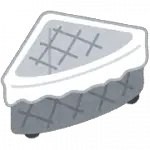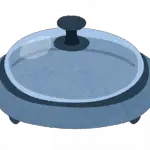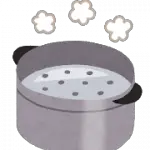「誰か私の手料理食べる勇気ある?」
=Dareka watashi no teryouri taberu yuuki aru?
=Anybody have the guts to eat my homemade dishes?
We have got a request from Itsumaru to make a lesson about dishes, the sink, water and soap, etc.
OK, I can teach you the basic kitchen related words today!
First of all, kitchen in Japanese is 台所 = daidokoro.
The old fashioned way to say kitchen is お勝手 = okatte.
We also call it キッチン = kicchin = kitchen :h:
![]() • システムキッチン = sisutemu kicchin = a unit kitchen, complete kitchen
• システムキッチン = sisutemu kicchin = a unit kitchen, complete kitchen
Now here is the list of the common kitchen utilities, and things you can find in any Japanese house.
It doesn’t cover the actual food or spices, etc., but if you’re interested drop me a line, and I will make another lesson!
:kkk: 台所用家具 = daidokoroyou kagu = kitchen furniture
• 食卓 = shokutaku = dining table
• ダイニングテーブル = dainingu teiburu = dining table
• 食器棚 = shokkidana = cupboard
![]() Burner range,
Burner range,
• ガスレンジ = gasu renji = ガスコンロ = gasu konro =gas burner range, gas cooker, gas stove
(Usually a double burner or triple burner and
![]() • 魚焼き器 = sakana yakiki = fish roaster
• 魚焼き器 = sakana yakiki = fish roaster
is built in.
• IHクッキングヒーター = ai eichi kukking hiitaa = IH cooking stove
:jjj: Kitchen appliances,
• オーブン = oobun = an oven
• 天火 = tenpi = an oven
• 電子レンジ = denshi renji = microwave oven
• 冷蔵庫 = reizouko = fridge
•コーヒーメーカー = koohii meekaa = a coffee maker
• 電気ポット = denki potto = an electric pot
• 換気扇 = kankisen = ventilation fan
• 炊飯器 = suihanki = rice cooker
• 電子ジャー = denshi jaa = electric rice cooker
• ホームベーカリー = hoomu beekarii = パン焼き器 = panyaki ki = electric bread machine
•トースター = toaster
•オーブントースター = toaster oven
•フードプロセッサー = fuudo purosessaa = food processor
•ミキサー = mikisaa = blender
•ホットプレート =hotto pureito = table top electric hot plate
(It is pretty common to have this appliance to cook 焼きそば = yakisoba = fried noodle or 焼き肉 = yakiniku=Japanese or Korean barbecue. )
• ジューサー = juusaa = juicer
• 卓上コンロ = takujou konro or カセットコンロ = kasetto konro = portable cooker, portable stove
• 食器洗い機 = shokki araiki = 食洗機 = shokusen ki = dish washer
Dishes, plates, bowls, etc.,
• 食器 = shokki = dishes
• 皿 = sara = plate(s)
• 大皿 = oozara = a big plate
• 小皿 = kozara = a small plate
• グラタン皿 = guratan zara = a gratin dish
• ワイングラス = wain gurasu = wine glass
• コップ = koppu = a glass
• グラス = gurasu = a glass
• コーヒーカップ = koohii kappu = a coffee cup
• ティーカップ = tii kappu =a tea cup
• 茶碗 = chawan = a rice bowl
• 湯のみ = yunomi= a tea cup for green tea
:: 台所用品 = daidokoro youhin = kitchen utilities,
• 鍋 = nabe = a pot, pan
• 中華鍋 = chuuka nabe = a wok
• 圧力鍋 = atsuryoku nabe = a high pressure cooker
• 蒸し器 = mushiki = a steamer
• やかん = yakan = a kettle
•フライパン = furaipan = frying pan
• まな板 = manaita =a cutting board
• はかり = hakari = a scale
• ボール = booru = a mixing bowl
• サラダボール = sarada booru = a salad bowl
• ざる = zaru = a draining basket
• 箸 = hashi = chopsticks
• 菜箸 = saibashi = long chopsticks for cooking
•しゃもじ = shamoji = a flat rice paddle
• 包丁 = houchou = a kitchen knife
• ナイフ = naifu = a knife
• バターナイフ = batta naifu = a butter knife
• フォーク = fooku = a fork
• スプーン = supuun = a spoon
• 計量スプーン = keiryou supuun = a measuring spoon
• 小匙 = 小さじ = kosaji = a tea spoon
• 大匙 = 大さじ = oosaji = a table spoon
(We also have 中匙 = 中さじ = chuusaji=middle sized spoon between a tea spoon and a table spoon.)
• 計量カップ = keiryou kappu = a measuring cup
• 缶切り = kankiri = a can opener
• 栓抜き= sennuki = a bottle opener
• コルク抜き = koruku nuki =ワインオープナー = wain oopunaa=a corkscrew
• 鍋つかみ = nabetsukami = an oven mitt
• お玉 = otama = a ladle
• フライ返し = furai gaeshi = a spatula
• 茶こし = chakoshi = tea strainer
• 泡立て器 = awadateki = an eggbeater
• 塩入れ = shioire =a salt shaker
• こしょう入れ = koshou ire = a pepper shaker
• 醤油入れ = shouyu ire or 醤油さし = shouyu sashi = a small bottle to keep soy sauce
• タッパー(ウェアー) = tappaa(ueaa) =a plastic container (tupperware)
:n: Around the sink,
• 流し台 = nagashidai = kitchen sink
• 流し = nagashi = kitchen sink
• 水切り台 = mizukiri dai = drainboard
• 三角コーナー = sankaku kooanaa = the place you throw garbage in the corner of the sink.

• 水道の蛇口 = suidou no jaguchi = water faucet
• 食器用洗剤 = senzai = dish soap
• 石けん = sekken = soap
• スポンジ = suponji = sponge
• たわし = tawashi = metallic sponge, wire wool
• ふきん = fukin = dishcloth
From the picture above,
:maggie-small: 「誰か私の手料理食べる勇気 ある?」
= Dareka watashi no teryouri taberu yuuki aru?
= Anybodyhave the guts to eat my homemade dishes? or Who has guts to eat my homemade dishes?
• 勇気 = yuuki =courage
→勇気がある= yuuki ga aru = to have courage / guts to do something,
• 手料理 = teryouri = homemade dishes
 マギー先生より= Maggie Sensei yori = From Maggie Sensei
マギー先生より= Maggie Sensei yori = From Maggie Sensei
今日のメニューはドッグフード、チキン入りです。おいしそ〜!
=Kyou no menuu wa doggu fuudo chikin iri desu. Oishiso~!
=Today’s meal is…Dog food with chicken. Looks yummy!
***
Will you be my Patron?
I appreciate your support! サポートありがとう!






20 Comments
RIP Maggie 😔😔😔
🐶💕💕💕
Teacher, can you make a list of Japanese words on theme: Housework , habits in life , economics. Thanks you so much
Hi,
“habits in life” you mean daily life related Japanese?
I don’t know about economics but I will add them in the request list. :)
Sensei!
Now I’m working at a restaurant and have a job in the kitchen. Could you help me listing some vocabularies so that I can communicate well with the other staff? Like phrases they use, indgredients name, the norm or the culture there…
Please :D
Hi Bloky,
Check my Cooking lesson and coffee shop and restaurant , fast food lesson.
(Just click the lesson titles. I added the link.) :)
こんにちわマギー先生!
I’ve been using your blog for grammar notes for some time now, and they have been very helpful!
レッスン作ってくれてありがとう!
I wanted to ask about the difference between 台所 and 厨房. Both means ‘kitchen’, but what is the difference in usage?
@ジュちゃん
こんにちは、ジュちゃん!
Happy to hear you have been using my site.
You use 台所 for your family kitchen. (In old day we used to call it 厨房)
厨房 is mainly used for a kitchen in a restaurants, coffee shops, or big places.
あ、すみませんでした。 I open up pages in browser tabs and don’t always read them right away. Guess I should have refreshed!
いつもレッスン作ってくれてありがとうございます。
@k
こちらこそ、いつも来てくれてありがとう!!
I tend to upload the lessons in hurry so there must be many typos and mistakes for the first few days. I always appreciate your help!
Thank you so much Maggie-sensei for adding my blog in your Maggie Recommends links! That’s an honor, and for the wrong pronunciations on smart fm goal i will check and fix all the items, i didn’t do that till now cause yesterday i was tired a lil bit after adding these 59 items, that gave me an idea about efforts you make to write and explain all these lessons for us, so Big Thanks for your amazing work! and please don’t forget to say hello to Gimmeabreakman :p
@yahiala14
No problem! Otsukaresama for all your work as well!
Oh, you know Victor (Gimmeabreakman)? I work with him so I will tell him you said hello! A bientot !
i am trying to do that :p, it too hard to find place for new Japanese words in my head these days, can i ask you to put my blog in your featured sites ?
@yahiala14
Sorry, I can’t touch this month’s featured sites now but I added your website in our Maggie’s recommendation link and mentioned your smart fm and blog in the lesson.
BTW, I have checked some of the pronunciation of the list you made and found some mistakes.
Ex. 泡立て器→should be “awadateki”. It reads “awadate utsuwa”
and 缶切り→should be “kankiri” but it reads “kansetsu
台所→should be ”daidokoro”It reads kichen etc.
I assume computer reads romaji automatically. It’s fun!
thank you for all your amazing lessons,that help me a lot to improve my Japanese, i made a goal on smart if someone like to memorize all these words the easy way :p
http://smart.fm/goals/535670
@yahiala14
Hello! You made the nice list there with pronunciation. So did you memorize the whole thing now?
Maggie-sensei, 鍋つかみ should be “potholder”. A panhandler is someone who begs!
@k
Thank you for spotting it. I always appreciate it. But how strange… I noticed it right after I released the lesson and changed it to oven mitt. It is fixed a week ago. Can you still see that????
Anyway, thank you for the comment.
Omg! I want to give a big thanks to Yukari and Maggie! I will cherish this lesson forever! Thank you so much for doing this everyday guys it means a lot to me! Take care. :)
@Itsumaru
You are welcome! どういたしまして!!We are glad to hear you like this lesson!!!